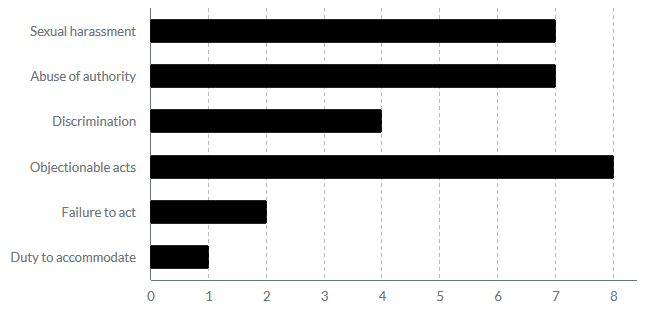Annual Report 2018-2019 on Workplace Harassment
Harassment Centre of Expertise (HCE), Employment and Social Development Canada (ESDC)
Message from ESDC’s Deputy Ministers
ESDC is committed to providing employees with a workplace where they feel welcome, respected and safe and where harassment has no place. With a workforce of over 29, 000 people, we are not immune to harassment. Preventing, addressing and resolving it requires ongoing and evolving efforts and is a top priority for us as your Deputy Ministers.
In 2018, we established the Harassment Centre of Expertise to provide employees and managers with access to neutral advisors and support to help resolve harassment-related issues. Since then, the Centre has expanded with enhanced services and programs dedicated to prevention and workplace restoration. We also launched a national awareness and prevention campaign to introduce helpful tools and resources and to ensure that this important dialogue continues. While there is still much work to be done, we are proud of the progress that has been made so far.
In this report, you will find a summary of the key activities undertaken in 2018-2019 to support ESDC employees. We firmly believe that each and every one of us plays an important role in preventing and resolving harassment and that, together, we can make our workplace what we want it to be.
Graham Flack
Deputy Minister of Employment and Social Development
Chantal Maheu
Deputy Minister of Labour
Benoît Robidoux
Associate Deputy Minister of Employment and Social Development
Lori MacDonald
Senior Associate Deputy Minister of Employment and Social Development and Chief Operating Officer for Service Canada
ESDC's Harassment Prevention and Resolution Framework
At ESDC, harassment complaints are managed in accordance with the Treasury Board of Canada Secretariat's (TBS) Policy on Harassment Prevention and Resolution and the Directive on the Harassment Complaint Process. As the department's Designated Official for Harassment Prevention and Resolution, Danièle Besner oversees the application of the policy and directive to ensure that harassment complaints are handled fairly, confidentially, effectively and in a timely manner and that steps are taken to restore the well-being of the workplace. She is supported in this role by the Harassment Centre of Expertise (HCE).
Under the TBS Policy, harassment is defined as: improper conduct by an individual, that is directed at and offensive to another individual in the workplace, including at any event or location related to work, and that individual knew or ought reasonably to have known would cause offence or harm. It comprises objectionable act(s), comment(s) or display(s) that demean, belittle, or cause personal humiliation or embarrassment, and any act of intimidation or threat. It also includes harassment within the meaning of the Canadian Human Rights Act (i.e. based on race, national or ethnic origin, colour, religion age, sex, sexual orientation, marital status, disability and pardoned conviction). Harassment is normally a series of incidents but can be one severe incident which has a lasting impact on the individual.
In accordance with the Policy, employees involved in a harassment situation must try to resolve it informally wherever possible. Managers are obligated to take action promptly whether or not a formal complaint has been made.
At any time, employees and managers have access to HCE advisors for impartial services and support to resolve harassment-related issues - with or without a formal complaint. Rest assured that, even if the situation does not meet the TBS definition of harassment, the HCE will work with all parties to help find solutions to resolve the situation. In cases where formal complaints are filed, they can sometimes be resolved within a few weeks, but, can often take longer, varying from 3 to 12 months depending on several factors, including:
- complexity;
- whether an investigation is required; and
- availability of parties and witnesses.
Other resources are also available to help you:
- Office of Informal Conflict Management
- Office of Values and Ethics
- Bargaining Agents
- Senior Disclosure Officer
Prevention and communication
We know that uncivil behaviour, if not managed, can lead to more serious situations. This is why ESDC's Deputy Ministers are committed to ensuring there are ongoing efforts to help employees and managers learn to recognize, prevent and address unacceptable behaviours across the spectrum from incivility to harassment and violence.
Harassment prevention and awareness campaign
In 2018-2019, the Harassment Centre of Expertise (HCE) launched a campaign to:
- educate employees about what harassment in the workplace is and is not;
- urge them to take action if they experience or witness harassment;
- inform them about the different options available; and
- encourage them to promote a respectful work environment.
Products, activities, tools and resources developed in 2018-2019:
- Intranet content
- Focus groups
- Emails and Corporate messages
- Toolkit for managers
- Video featuring our DMs
- Articles and Blog posts
- Infographics for employees and managers
- Questions of the week
- Pulse Survey
Training
In addition to the training courses offered by the Canada School of Public Service (CSPS) on harassment, violence and civility in the workplace, ESDC has developed complementary training, including:
- Respectful Workplaces / Harassment Prevention: 98 sessions / 2267 employees;
- Civility and a Healthy, Respectful Workplace;
- Doing Things Right & Doing the Right Thing: Putting the Departmental Code of Conduct into Action;
- Behaviours in Conflict Situations; and much more.
Resolution and restoration
Consultations
The HCE provides consultation services that include:
- requests for information about our programs;
- advice on a specific situation; and
- requests for information about procedures, etc.
In the 2018-2019 fiscal year, there were: 138 consultations
Restoration and Workplace Initiatives Program
Since 2018, the HCE has continued to develop its workplace restoration program in order to help teams affected by a harassment complaint or where many conflicts of different natures exist. The HCE works in collaboration with its partners to:
- identify workplaces that need help and support;
- create joint intervention strategies to help teams; and
- develop and execute restoration plans that include personalized activities related to the different issues identified.
In fiscal year 2018-2019, the HCE worked on: 21 Restoration files
Harassment Complaint Resolution Program
The harassment complaint resolution team manages harassment-related situations - with or without a formal complaint. The graphs that follow provide an overview of the formal complaints filed in 2018-2019. When we compare the number of complaints to the number of ESDC employees who reported experiencing workplace harassment in the last 12 months in the 2018 Public Service Employee Survey (13%), it is clear that the majority of victims are not coming forward. We are committed to seeing this change and will continue our efforts to raise awareness and support and equip employees to speak up.
In fiscal year 2018-2019, we received: 67 Complaints
Status of complaints as of March 31, 2019

 Founded (17)
Founded (17)  Not founded (12)
Not founded (12)  Dismissed (18)
Dismissed (18)  Inadmissible (9)
Inadmissible (9)  Under investigation (11)
Under investigation (11)
Long description
Category descriptions:
- Founded:
- The investigation concluded that the harassment described in the complaint is founded (17);
- Not founded:
- The investigation concluded that the harassment described in the complaint is not founded (12);
- Dismissed:
- The analysis concluded that the harassment described in the complaint does not meet the TBS definition of harassment (18);
- Inadmissible:
- The complaint doesn't respect the prescribed timelines in the TBS Policy (a complaint must be filed within 12 months of the last harassment incident),or the complaint was withdrawn (9); and
- Under investigation:
- At the end of the 2018-2019 fiscal year, the complaint was still under investigation, and no decision was rendered (11).
Types of harassment (based on founded complaints)
Note: Individual complaints may involve several types of harassment.

Long description
Type of harassment (based on founded complaints)
- Sexual harassment is related to 7 founded complaints.
- Abuse of authority is related to 7 founded complaints.
- Discrimination is related to 4 founded complaints.
- Objectionable acts is related to 8 founded complaints.
- Failure to act is related to 2 founded complaints.
- Duty to accommodate is related to 1 founded complaint.
Consequences
At ESDC, no reported situation of harassment is overlooked and founded cases are managed through appropriate corrective and disciplinary action. Action taken can include coaching, oral and written reprimands, suspension, demotion, deployment without consent and termination of employment, where warranted. Management is accountable for ensuring that the nature of discipline is to be corrective, rather than punitive. When determining appropriate disciplinary measures, managers review each situation on a case-by-case basis, taking many factors into consideration, such as: mitigating and aggravating factors, past disciplinary record, and relevant jurisprudence.
For all 17 founded cases in 2018-2019, disciplinary and corrective measures were taken. The following examples demonstrate the nature of the behaviours, and consequences of some the founded harassment cases in 2018-2019:
- An employee who displayed objectionable behaviour towards another employee in the workplace received a one – day suspension;
- A team leader who abused their authority in the workplace received a 9 – day suspension; and
- An executive who sexually harassed an employee in the workplace was terminated.
What we noticed…
The number of complaints continues to increase every year, which is a potential indicator that more people are feeling comfortable bringing forward harassment-related issues and that they know where to go for help.
2018-2019 had the highest number of founded complaints on record.
Witnesses play a crucial role in fighting harassment. Research shows that in 80% of cases, bullying occurs in front of witnesses, and in 57% of cases, the bullying stops within 10 seconds after a witness steps in.
What’s ahead…
Prevention
The HCE and its partners continue to promote respect in the workplace through the awareness and prevention campaign, and to develop tools that help and encourage employees to speak up when facing harassment situations. Several new products, resources and tools to equip employees and managers are planned for the 2019-2020 fiscal year:
- podcast series;
- corporate articles and messages;
- intranet content;
- posters on subtle forms of harassment; and
- informative products and training sessions in advance of pending regulations under the Canada Labour Code.
